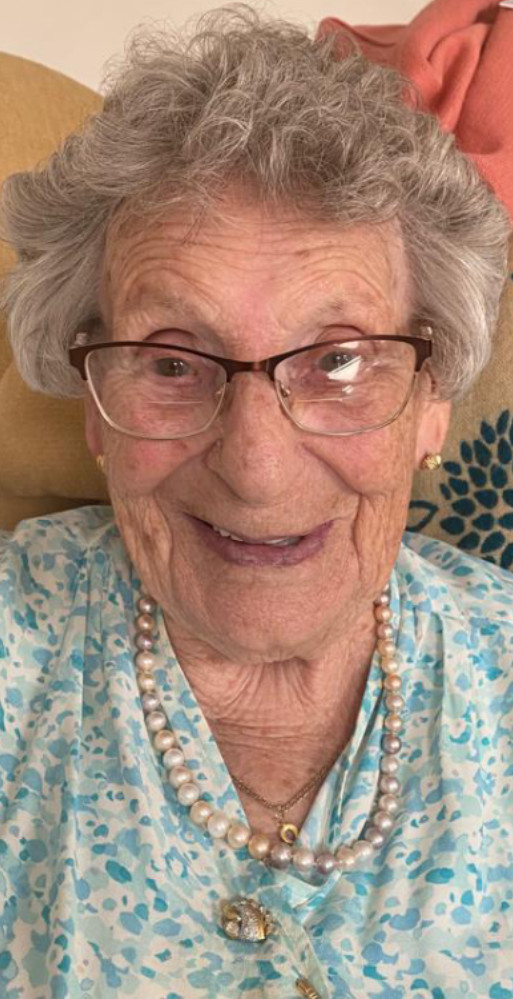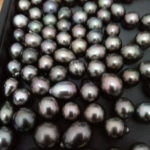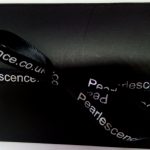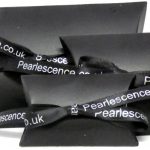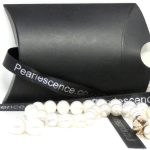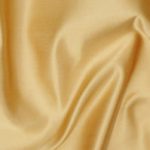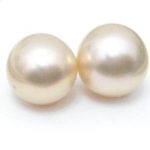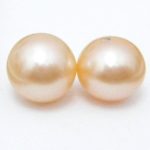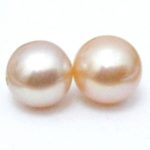AAA Grading system
Pearls are usually graded between A and AAA, with A being not very good to AAA which should be of the specific shape (usually used for round pearls) smooth surfaced (with only very small and near invisible flaws) and of high shine or lustre
AA+ Nearly as good as AAA but perhaps slightly off round when rolled and a few more flaws although these will still only be visible on close inspection. Look closely below- the halos are slightly oval because the pearls are off-round although the halos are still pretty regular
AA Average to good lustre, off round, blemishing to 20% of surface
A: This is the lowest jewellery-grade pearl, with a lower lustre and/or more than 25% of the surface showing defects. Probably a ’round’ pearl will be egg shaped, even from a distance
The problem with this system is, of course, that you may be faced with a smooth surfaced and metallic pearl which is off round to the point where it drops from AAA to AA+ or even AA. It will still be a beautiful pearl and one which will probably look round when worn but many buyers will be deterred by an AA grading.The lustre reflection below differs noticeably between pearls in terms of reflection and shape and the one to the left of centre has a grooved surface flaw’
A+ Low quality. Visibly off round and very variable lustre. Many flaws in the surface
(any website or other seller which talks about AAAA+++ grade pearls is talking rubbish and this should be challenged).
Tahitian pearls have a distinct and separate system, established by GIE Perles de Tahiti, and the Ministere de la Perliculture of Tahiti which grades from A (finest) to D ( poor) but to avoid confusion Pearlescence uses only the A-AAA gradings throughout the website.
We also have adopted the name ‘Essence’ for pearls which are exceptional. They have been selected for highly metallic lustre, clean surface and shape, in that order. Usually only found by selecting in person. Probably under 1% of pearls will show the mirror metallic lustre we look for
Abalone Pearls
Research and new farming for abalone pearls has started in New Zealand in the last few years..

The abalone produces a distinctive and tunningly iridescent blue pearl but is very hard to nucleate as its blood does not clot, so any damage will kill it.There are natural (wild) abalone pearls out there, with wildly baroque shapes and a distinctive horn shape tapering from a broad and sometimes distorted and ugly base to a sharp tip
Akoya
Akoya pearls come from the akoya oyster (Pinctada Fucata Martensii), which is the smallest pearl producing oyster (6cm to 8cm). This is why akoya pearls over 10mm are very rare while the normal size is about 6mm to 7mm It is a salt water mollusc.

Little akoya pearl oyster
Most cultured sea pearls are akoya pearls which are made with a bead nucleus, so that they usually have a good round shape. Big irregularities tend to be tails while less than perfect pearls have nacre with pits or convolutions. Good akoya pearls have a sharply reflective metallic lustre. Most akoya pearls come from Japan with a small production in China.
Akoya oysters like to live in water one to five metres deep and in temperatures of between 15 to 24 degrees Celsius
Modern pearl farming began properly in 1905 when Kokichi Mikimoto produced the first round farmed pearls. The company which still bears his name continues to be a world leader in the provision of the finest akoya pearls
Akoya pearls are harvested after only 9-16 months. The main thing to be aware of is that akoya pearls which are too cheap can have only the thinnest layer of nacre. Pearls with very thin nacre may even ‘blink’ which means that when rolled the nacre blinks to show patches where there is no nacre and you can see the nucleus. Below is a very bad example – the cream colour is nacre and the white is nucleus. Even when the nacre appears solid it can be very thin: peer closely and you can just about make out the thin line of the black nacre on the akoya pearl on the left (which split in half) The nacre on the pearl on the right is so thin the pearl is a ‘blinker’ .

Very thin black nacre Nacre so thin the bead is visible in places

You can see the thin akoya nacre
in these split pearls


Recently the trend for natural colour pearls has spread to akoya pearls and where once
Blue single vietnamese akoya pearl grey blue round akoya strand
every akoya pearl would have been bleached to make it white (and then often pinked to give a pink overtone) now akoya are available in delicate natural shades of pink, grey, or gold as well as a dark grey/blue which also has strong green highlights
Most white akoya are bleached, though some natural white are available. Black akoya are dyed and can look too uniform and dense in colour, while it is also hard to find gold akoya which haven’t been dyed. Suspect strong gold tones and opt for delicate blush tones


Natural pale gold akoya pearls. Natural mixed colour akoyas
